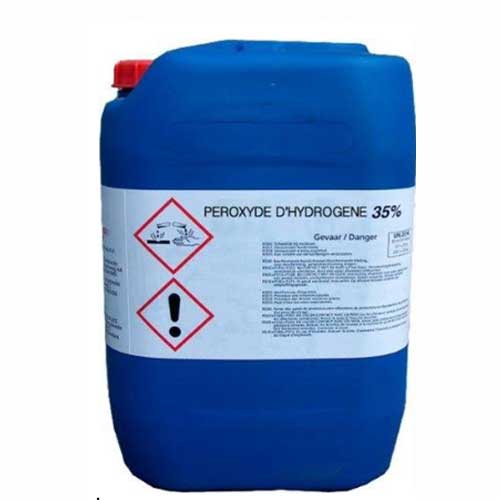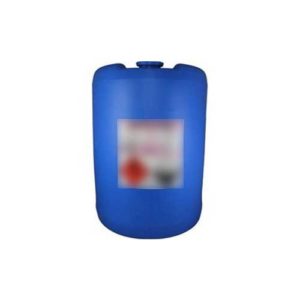HYDROGEN PEROXIDE (35 % & 50 %) – H2O2
ABOUT:
- The hydrogenation of anthraquinone is the first step in the production of hydrogen peroxide. Anthraquinone is a yellow crystalline compound derived from coal tar. In the presence of a catalyst, hydrogen gas is passed over anthraquinone to form dihydroanthraquinone.
- After that, the dihydroanthraquinone is oxidised with air or oxygen to produce hydrogen peroxide. This reaction is typically carried out in a series of reactors containing a dihydroanthraquinone solution in an organic solvent.
- The hydrogen peroxide solution is then purified to remove impurities and stabilisers added during the manufacturing process. The most common stabilisers are sodium stannate and phosphoric acid. The solution is typically purified through a series of steps that include filtration, distillation, and chemical treatment.
- Finally, the purified hydrogen peroxide solution is concentrated to the desired strength by removing the excess water. This is typically accomplished by passing the solution through a series of distillation columns or by using a vacuum distillation process. Depending on the application, the strength of the resulting hydrogen peroxide solution can range from 35% to 50%.
PHYSICAL PROPERTIES:
Appearance: clear, colorless liquid
Molecular weight: 34.01 g/mol
Density (35% solution): 1.13 g/cm³
Density (50% solution): 1.20 g/cm³
Boiling point (35% solution): 107°C
Boiling point (50% solution): 114°C
Freezing point (35% solution): -33.3°C
Freezing point (50% solution): -51.3°C
Vapor pressure (35% solution): 23.3 mm Hg at 25°C
Vapor pressure (50% solution): 55 mm Hg at 25°C
CHEMICAL PROPERTIES:
- Hydrogen peroxide is highly soluble in water and forms an azeotrope at a concentration of 90.2% at normal atmospheric pressure.
- Hydrogen peroxide is a strong oxidizing agent and can react with many organic and inorganic compounds. It is also sensitive to heat, light, and contact with certain metals and can decompose explosively in the presence of certain catalysts.
- Hydrogen peroxide is used in various industrial and household applications, including bleaching, disinfection, and chemical synthesis.
- Hydrogen peroxide is a corrosive substance that can cause burns and eye damage. It is also a respiratory irritant and can cause lung damage when inhaled. Therefore, it should be handled with care, and protective equipment should be used when working with high concentrations.
APPLICATIONS:
CHEMICAL INDUSTRY:
- Hydrogen peroxide is widely used as a bleaching agent in the paper and pulp industry, as well as in textile manufacturing. It is also used to whiten bones and teeth.
- Hydrogen peroxide is an effective disinfectant and is commonly used to sterilize medical equipment and surfaces in hospitals and laboratories.
- Hydrogen peroxide is used as a reactant in the synthesis of many chemicals, such as propylene oxide, epichlorohydrin, and adipic acid.
HEALTHCARE INDUSTRY:
- Hydrogen peroxide is a powerful disinfectant that can kill bacteria, viruses, and fungi. It is used to sterilize medical equipment, surfaces, and even the air in hospital rooms.
- Hydrogen peroxide is used as a mouthwash to help kill bacteria in the mouth and prevent gum disease. It can also help whiten teeth and freshen breath.
- Hydrogen peroxide is used in skincare and hair care products for its ability to exfoliate and unclog pores on skin and hair.
FOOD INDUSTRY:
- Clean and sanitise food processing equipment and surfaces, as well as wash fruits and vegetables, with hydrogen peroxide. It’s also used as a bleaching agent to remove stains from foods like flour, sugar, and milk.
- Hydrogen peroxide is an effective oxidizing agent that can be used to treat food products such as meats, fish, and fruits to prevent spoilage and extend their shelf life. It is also used to remove excess chlorine from water used in food processing.
ELECTRONICS INDUSTRY:
- Hydrogen peroxide is used in the etching process of PCBs to remove unwanted copper from the surface. When mixed with hydrochloric acid or sulfuric acid, it can oxidize the copper, resulting in the formation of copper ions that can be easily removed from the PCB.
- Hydrogen peroxide can be used to modify the surface properties of electronic components.
- It is used to disinfect cleanrooms, manufacturing equipment, and other areas in electronics manufacturing facilities.
WATER TREATMENT INDUSTRY:
- Hydrogen peroxide can be used to remove unpleasant odors and tastes from water, particularly in the treatment of drinking water.
- Hydrogen peroxide can be used to break down and remove organic matter from water, including oils, greases, and other pollutants.
- Hydrogen peroxide can be used to remove color from water that is caused by organic compounds, such as humic acid.
- Hydrogen peroxide can be used in combination with iron salts to create Fenton’s reagent, which is an effective method for removing pollutants, such as organic chemicals and heavy metals, from wastewater.
ENERGY INDUSTRY:
- Hydrogen peroxide is used as a propellant in rockets and missiles. When mixed with a fuel such as kerosene or hydrazine, it decomposes rapidly to produce a high-temperature, high-pressure gas that propels the vehicle.
- Hydrogen peroxide can be used as a fuel in fuel cells to generate electricity. It is also used in gas turbines to improve combustion efficiency.
AGRICULTURE INDUSTRY:
- Hydrogen peroxide can be used to oxygenate soil. This can help to increase the availability of oxygen to plant roots and promote the growth of healthy plants.
- Hydrogen peroxide can be used to treat seeds to prevent the growth of fungal pathogens and to promote germination.
SAFETY MEASURES:
- Wear appropriate personal protective equipment (PPE) including gloves, goggles, and a lab coat.
- Handle the chemical in a well-ventilated area to avoid inhalation of vapors or aerosols.
- Use a properly labeled and secured container to store and transport the hydrogen peroxide.
- Store the hydrogen peroxide away from flammable or combustible materials.
- Do not mix hydrogen peroxide with other chemicals unless instructed to do so by a qualified person.
- In case of accidental contact with skin or eyes, immediately flush the affected area with water for at least 15 minutes and seek medical attention.
- Have a spill kit readily available in case of accidental spills.
- Dispose of the hydrogen peroxide in accordance with local regulations.
- Train and inform all personnel who may handle hydrogen peroxide about its properties and safe handling procedures
PACKAGING:
- Hydrogen peroxide (H2O2) at 35% and 50% concentrations is typically packed in containers made of high-density polyethylene (HDPE) plastic, which is a durable and chemically resistant material that can withstand hydrogen peroxide’s reactive properties. And it comes in 30 and 50kgs carboy.





Reviews
There are no reviews yet.